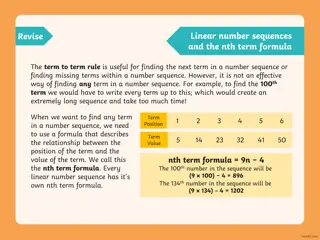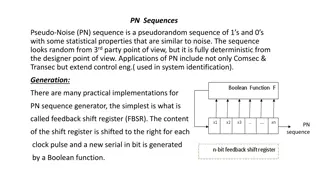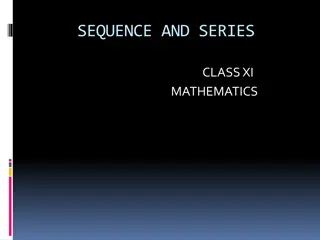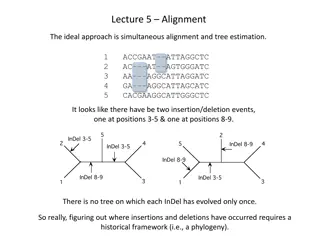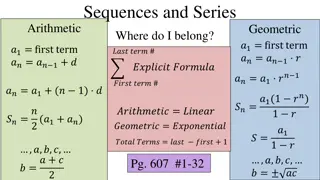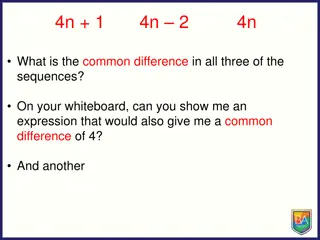Understanding Sequences in Mathematics
Explore arithmetic, geometric, and Fibonacci sequences along with their general forms and properties. Learn how to define sequences and terms, and understand the concepts of indices and common differences/common ratios.
Download Presentation

Please find below an Image/Link to download the presentation.
The content on the website is provided AS IS for your information and personal use only. It may not be sold, licensed, or shared on other websites without obtaining consent from the author. Download presentation by click this link. If you encounter any issues during the download, it is possible that the publisher has removed the file from their server.
E N D
Presentation Transcript
Induction-first (Chapter 7.1- 7.5) Some slides have been taken from the sites http://cse.unl.edu/~choueiry/S13-235/
Motivation How can we prove the following proposition? x A S(x) For a finite set A={a1,a2, ,an}, we can prove that S(x) holds for each element because of the equivalence S(a1) S(a2) S(an) For an infinite set, we can try to use universal generalization Another, more sophisticated way is to use induction
Sequences Well known sequences Arithmetic sequence 1, 4, 7, 10, 14, . Geometric sequence 1, 3, 9, 27, .. Fibonacci sequence 1, 1, 2, 3, 5, 8, .....
Arithmetic sequence General form: <a, (a+d), (a+2d), ..> a is the initial value and d is the common difference a = 1 and d=3 realize the sequence <1, 4, 7, .> a = 3, d=3 realize the sequence <3, 7, 10, >
Arithmetic sequence General form: <a, (a+d), (a+2d), ..> Let S(n) denote the nth term of the sequence; n is called the index. We can define a function S: {1, 2, 3, ..} Z such that S(n) = a + (n-1) d, for given a and d. The is denoted by {S(n)} or { Sn }. S(1) is the initial term
Geometric sequence General form: <a, ar, ar2, ar3 ..> a is the initial value and r is the common ratio a = 1 and r=3 realize the sequence <1, 3, 32, .> a = 3, r=3 realize the sequence <3, 3.31, 3.32, .>
Geometric sequence General form: <a, ar, ar2, ar3 ..> Let S(n) denote the nth term of the sequence; n is called the index of the term. We can define a function S: {1, 2, 3, ..} Z such that S(n) = a. r(n-1), for given a and r. The is sequence is denoted by {S(n)} or { Sn }. S(1) is the initial term
Fibonacci sequence Form: <1, 1, 2, 3, 5, ..> 1 is the initial value Let S(n) denote the nth term of the sequence; n is called the index of the term. We can define a function S: {1, 2, 3, ..} Z such that S(n) = The is sequence is denoted by {S(n)} or { Sn }. S(1) is the initial term
More definitions: our sequence is {an} increasing A sequence is increasing if for every two consecutive indices, k and k + 1, in the domain, ak< ak+1. non-decreasing A sequence is non-decreasing if for every two consecutive indices, k and k + 1, in the domain, ak ak+1..
More definitions: our sequence is {an} decreasing A sequence is decreasing if for every two consecutive indices, k and k + 1, in the domain, ak> ak+1. non-increasing A sequence is non-increasing if for every two consecutive indices, k and k + 1, in the domain, ak ak+1.
Problem 7.1.2 of the text Do it in the class
Recurrence relation recurrence relation A rule that defines a term anas a function of previous terms in the sequence is called a recurrence relation. Arithmetic sequence: <t, t+d, t+2d, ., t+(n-1)d, > Let the sequence be {an}. an = t + (n-1)d; an-1= t + (n-2)d an = an-1 + d is the recurrence relation of {an}, n 2. a1 = t (initial value)
Geometric sequence {Sn}, n 1 Geometric sequence: <a, ar, a+r2, ., arn-1, > Let the sequence be {an}. Sn = arn-1; Sn-1= arn-2 Sn = r Sn-1 is the recurrence relation of {Sn}, n 2. S1 = a (initial value)
Fibonacci sequence {Fn} The sequence is <1, 1, 2, 3, 5, 8, .> Let the sequence be {Fn}. Fn = Fn-1 + Fn-2 is the recurrence relation of {Fn}, for n 3. F1 = 1; F2 = 1 (initial values) In the text, the recurrence relation for Fibonacci sequence is given by Fn = Fn-1 + Fn-2 for n 2 F0 = 0; F1 = 1 (initial values) The sequence it generates is <0, 1, 1, 2, 3, 5, 8, > The value of the 0th term is 0.
Example 7.2.3: Outstanding balance on a car loan. An individual takes out a $20,000 car loan. The annual interest rate for the loan is 3%. The person wishes to make a monthly payment of $500. Define anto be the amount of outstanding debt after n months. Since the interest rate describes the annual interest, the percentage increase each month is actually 3% / 12 = 0.25%. Thus, the multiplicative factor increase each month is 1.0025.
Example 7.2.3: Outstanding balance on a car loan. The recurrence relation for {an} is: Few initial values:
Summation Summation notation Summation notation is used to express the sum of terms in a numerical sequence. Index, lower limit, upper limit In the summation. the variable i is called the index of the summation. The variable s is the lower limit, and the variable t is the upper limit of the summation. = as + as+1 + .. + at is the expanded form.
Closed form A closed form for a sum is a mathematical expression that expresses the value of the sum without summation notation.
Closed form A closed form for a sum is a mathematical expression that expresses the value of the sum without summation notation.
Change of variables in summations. We have seen that
Change of variables in summations. We have seen that Therefore,
Change of variables in summations. We have seen that Therefore, Let j = i -1; j = 0 when i = 1, and j = n- 1 when i = n. We then get
Principle of Mathematical Induction To prove that a statement S(n) is true for all positive integers n (i.e. n Z+) , we perform two steps: Basis step: We verify that S(1) is true. Inductive step: We show that the conditional statement S(k) S(k+1) is true k Z+ Symbolically, the statement (S(1) (k 1) (S(k) S(k+1))) (n Z+) S(n)
Principle of Mathematical Induction How do we do this? S(1) is usually an easy property to show. To prove the conditional statement, we assume that S(k) is true (it is called inductive hypothesis) and show that under this condition S(k+1) is also true.
Mathematical Induction It is a powerful proof techniques.
Mathematical Induction It is a powerful proof techniques. The Domino Effect Show that all dominos fall. Basis Step: The first domino falls. Inductive step: Whenever a domino falls, its next neighbor will also fall.
Mathematical Induction Two components of inductive proof. The base case establishes that the theorem is true for the first value in the sequence. The inductive step establishes that if the theorem is true for k, then the theorem also holds for k + 1.
Another View To look at it in another way, assume that the statements S(1) S(k) S(k+1) are true. We can now use a form of universal generalization as follows:
Another View To look at it in another way, assume that the statements (1) S(1) (2) S(k) S(k+1) are true. We can now use a form of universal generalization as follows. Say we choose an element c of Z+. c is finite. We wish to establish that S(c) is true. If c=1, then we are done.
Another View To look at it in another way, assume that the statements (1) S(1) (2) S(k) S(k+1) are true. We can now use a form of universal generalization as follows. Z+. Say we choose an element c of N. c is finite. We wish to establish that S(c) is true. If c=1, then we are done. Otherwise, we apply (2) above to get S(1) S(2), S(2) S(3), S(3) S(4), , S(c-1) S(c) via a finite number of steps (c-1) we get that S(c) is true.
Another View To look at it in another way, assume that the statements (1) S(1) (2) S(k) S(k+1) are true. We can now use a form of universal generalization as follows. Z+. Z+. Say we choose an element c of N. c is finite. We wish to establish that S(c) is true. If c=1, then we are done. Otherwise, we apply (2) above to get S(1) S(2), S(2) S(3), S(3) S(4), , S(c-1) S(c) via a finite number of steps (c-1) we get that S(c) is true. Because c is arbitrary, the universal generalization is established and n Z+ S(n)
Example 1 Prove that for any integer n 1, 22n-1 is divisible by 3. Define S(n) to be the statement 3 | (22n-1).
Example 1 Prove that for any integer n 1, 22n-1 is divisible by 3 Define S(n) to be the statement 3 | (22n-1) We note that for the basis case n=1, we do have S(1) 22 1-1 = 3 is divisible by 3.
Example 1 Prove that for any integer n 1, 22n-1 is divisible by 3 Define S(n) to be the statement 3 | (22n-1) We note that for the basis case n=1 we do have P(1) 22 1-1 = 3 is divisible by 3 Next we assume that S(k) holds. That is, there exists some integer t such that 22k-1 = 3t. (Inductive hypothesis)
Example 1 Prove that for any integer n 1, 22n-1 is divisible by 3 Define S(n) to be the statement 3 | (22n-1) We note that for the basis case n=1 we do have S(1) 22 1-1 = 3 is divisible by 3 Next we assume that S(k) holds. That is, there exists some integer t such that 22k-1 = 3t. (Inductive hypothesis) We must prove that S(k+1) holds. That is, 22(k+1)-1 is divisible by 3.
Example 1 (contd.) Note that: 22(k+1) 1 = 2222k -1=4.22k -1
Example 1 (contd.) Note that: 22(k+1) 1 = 2222k -1=4.22k -1 The inductive hypothesis: 22k 1 = 3t 22k = 3t+1
Example 1 (contd.) Note that: 22(k+1) 1 = 2222k -1=4.22k -1 The inductive hypothesis: 22k 1 = 3t 22k = 3t+1 Thus: 22(k+1) 1 = 4 22k -1 = 4(3t+1)-1 = 12t+4-1 = 12t+3 = 3(4t+1), a multiple of 3
Example 1 (contd.) Note that: 22(k+1) 1 = 2222k -1=4.22k -1 The inductive hypothesis: 22k 1 = 3t 22k = 3t+1 Thus: 22(k+1) 1 = 4 22k -1 = 4(3t+1)-1 = 12t+4-1 = 12t+3 = 3(4t+1), a multiple of 3 We conclude, by the principle of mathematical induction, for any integer n 1, 22n-1 is divisible by 3.
Example 2 (page 154) Open Statement S(n) = Sn: 1 + 3 + 5 + ..+ (2n-1) = n2 . The rest of the details will be shown in the class.
Example 2 (page 154) Open Statement S(n) = Sn: 1 + 3 + 5 + ..+ (2n-1) = n2 . S1 is true. The rest of the details will be shown in the class.
Example 3: Summation Show that for all n 1. The basis case is trivial: for n =1, 13 = 12 The inductive hypothesis assumes that for some n 1 we have i=1k (i3) = ( i=1k i)2 We now consider the summation for (k+1): i=1k+1 (i3) = ( i=1k i)2 + (k+1)3= ( k(k+1)/2 )2 + (k+1)3 = ( k2(k+1)2 + 4(k+1)3 ) /22= (k+1)2 (k2 + 4(k+1) ) /22 = (k+1)2 ( k2 +4k+4 ) /22= (k+1)2 ( k+2)2 /22 = ((k+1)(k+2) / 2) 2 Thus, by the PMI, the equality holds
Examples n
Z+ S(1) S(n) S(k) S(k+1)) Z+ S(n) S(n) S(1) S(a-1) S(a) S(a-1)
Example Show that any number larger than 43 can be written as the sum of nonnegative multiples of 6, 9, or 20. i.e n = 6 t1 + 9 t2 + 20 t3, where t1, t2, t3 0, n 44.
Example Show that any number larger than 43 can be written as the sum of nonnegative multiples of 6, 9, or 20. i.e n = 6 t1 + 9 t2 + 20 t3, where t1, t2, t3 0, n 44. Consider n=1,2,3, . We notice that only the numbers 6, 9, 12, 15, 18, 20, 21, 24, 26, 27, 29, 30, 32, 33, 36, 38, 39, 40, 42 (less than 43) can be expressed as the sum of 6 and 9. However, 43 is not expressible as the sum of 6, 9, and 20.




